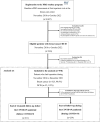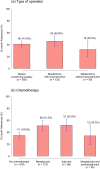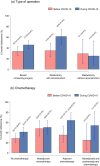Longitudinal assessment of real-world patient adherence: a 12-month electronic patient-reported outcomes follow-up of women with early breast cancer undergoing treatment
- PMID: 38740611
- PMCID: PMC11090970
- DOI: 10.1007/s00520-024-08547-7
Longitudinal assessment of real-world patient adherence: a 12-month electronic patient-reported outcomes follow-up of women with early breast cancer undergoing treatment
Abstract
Background: Electronic patient-reported outcomes (ePROs) assess patients' health status and quality of life, improving patient care and treatment effects, yet little is known about their use and adherence in routine patient care.
Aims: We evaluated the adherence of invasive breast cancer and ductal carcinoma in situ (DCIS) patients to ePROs follow-up and whether specific patient characteristics are related to longitudinal non-adherence.
Methods: Since November 2016, the Breast Center at Charité - Universitätsmedizin Berlin has implemented an ongoing prospective PRO routine program, requiring patients to complete ePROs assessments and consent to email-based follow-up in the first 12 months after therapy starts. Frequencies and summary statistics are presented. Multiple logistic regression models were performed to determine an association between patient characteristics and non-adherence.
Results: Out of 578 patients, 239 patients (41.3%, 95%CI: 37.3-45.5%) completed baseline assessment and all five ePROs follow-up during the first 12 months after therapy. On average, above 70% of those patients responded to the ePROs follow-up assessment. Adherence to the ePROs follow-up was higher during the COVID-19 pandemic than in the time periods before (47.4% (111/234) vs. 33.6% (71/211)). Factors associated with longitudinal non-adherence were younger age, a higher number of comorbidities, no chemotherapy, and a low physical functioning score in the EORTC QLQ-C30 at baseline.
Conclusions: The study reveals moderate adherence to 12-month ePROs follow-up assessments in invasive early breast cancer and DCIS patients, with response rates ranging from 60 to 80%. Emphasizing the benefits for young patients and those with high disease burdens might further increase adherence.
Keywords: Compliance; Early Breast cancer; Oncology; Return rate; Web-based questionnaire.
© 2024. The Author(s).
Conflict of interest statement
The authors declare no competing interests.
The authors declare no competing interests.
Figures




Similar articles
-
Real-world reference scores for EORTC QLQ-C30 and EORTC QLQ-BR23 in early breast cancer patients.Eur J Cancer. 2022 Mar;163:128-139. doi: 10.1016/j.ejca.2021.12.020. Epub 2022 Jan 20. Eur J Cancer. 2022. PMID: 35066338
-
Satisfaction with care and adherence to treatment when using patient reported outcomes to individualize follow-up care for women with early breast cancer - a pilot randomized controlled trial.Acta Oncol. 2020 Apr;59(4):444-452. doi: 10.1080/0284186X.2020.1717604. Epub 2020 Jan 31. Acta Oncol. 2020. PMID: 32000559 Clinical Trial.
-
Electronic reporting of patient-reported outcomes in a fragile and comorbid population during cancer therapy - a feasibility study.Health Qual Life Outcomes. 2020 Jul 11;18(1):225. doi: 10.1186/s12955-020-01480-3. Health Qual Life Outcomes. 2020. PMID: 32653005 Free PMC article.
-
Electronic patient-reported outcome measures (ePROs) as tools for assessing health-related quality of life (HRQoL) in women with gynecologic and breast cancers: a systematic review.Digit Health. 2024 Nov 10;10:20552076241297041. doi: 10.1177/20552076241297041. eCollection 2024 Jan-Dec. Digit Health. 2024. PMID: 39529915 Free PMC article. Review.
-
Quality of life issues in patients with ductal carcinoma in situ: a systematic review.Support Care Cancer. 2024 Oct 1;32(10):695. doi: 10.1007/s00520-024-08864-x. Support Care Cancer. 2024. PMID: 39352516
Cited by
-
Factors Associated With Self-Report Symptom Screening Adherence in Pediatric Cancer Patients.Cancer Med. 2025 Jul;14(14):e71053. doi: 10.1002/cam4.71053. Cancer Med. 2025. PMID: 40686265 Free PMC article. Clinical Trial.
-
Does transanal total mesorectal excision (taTME) result in better quality of life and functional outcomes than traditional TME does? A retrospective propensity score-adjusted cohort study.Langenbecks Arch Surg. 2025 Apr 30;410(1):149. doi: 10.1007/s00423-025-03724-6. Langenbecks Arch Surg. 2025. PMID: 40304801 Free PMC article.
-
Demographic and socioeconomic determinants of adherence in digital patient-reported outcomes among patients with chronic diseases.NPJ Digit Med. 2025 Aug 1;8(1):492. doi: 10.1038/s41746-025-01899-2. NPJ Digit Med. 2025. PMID: 40751085 Free PMC article.
References
-
- Singh K, Landman AB (2017) Chapter 13 - mobile health. In: Sheikh A, Cresswell KM, Wright A, et al (eds). Key advances in clinical informatics. Academic Press, pp 183-196. 10.1016/B978-0-12-809523-2.00013-3
MeSH terms
LinkOut - more resources
Full Text Sources
Medical

